Christy Gast: Twisted Sisters
February 12th - March 31st, 2025The works in this series began as drawings, visions of entwined bodies superimposed on the very basic structure of cloth: twist, warp and weft. Loose fibers bound together through a twisting motion form a line, a thread. As warp and weft, a grid, the line can be manipulated into a plane, a fabric, which as a garment can be given dimensionality and flow through time and space as an adjunct skin.
The sculptures begin with flow, play, and joy in the studio. The drawings surprise me with their sensuality and with the challenge to make an impossible object–a body with no beginning or end, a body with no body, a poetic body. I must make the object seem like it was always already there, fully formed, inconceivable in its previous state–flat white cloth on a table or 3×1 twill on an industrial loom. I revel in the technical work and the poetry that seeps out of textile processes.
-
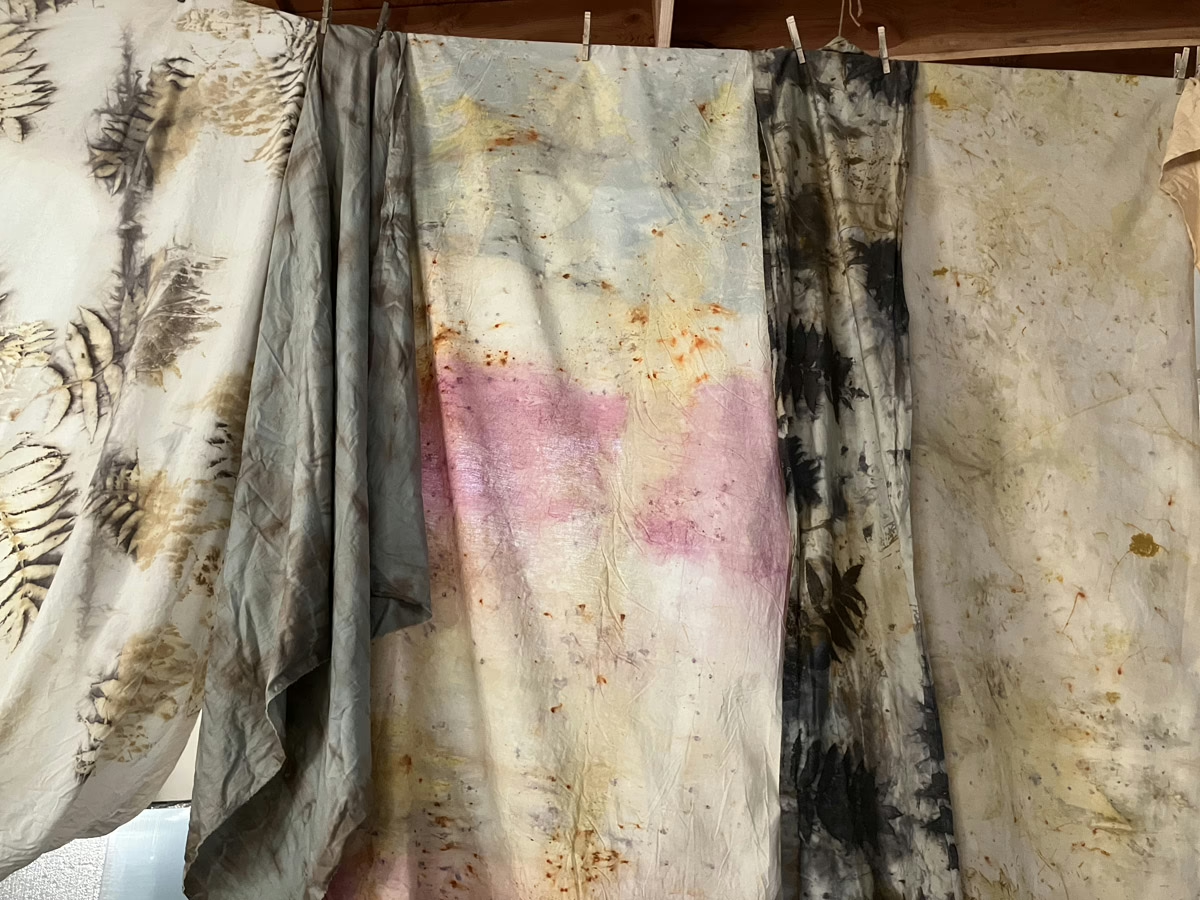
Plant-dyed fabrics in Christy's studio.
In the past 10 years, a lot of my creative work was done with Ensayos, a research-based, collective and interdisciplinary practice. It has been my privilege to take part in fieldwork in Tierra del Fuego and the Arctic where I was immersed in aqueous eco-cultural landscapes with Indigenous and ecological activists, scientists and all scale of creatures–from whales to tardigrades. The somatic, inquisitive, multisensory, community-building workstyles we developed with Ensayos remain with me in the studio.
For dyed works like “Four Button Fly”, the process for producing dyed monoprints of plants on denim was developed through research, trial and error. I began working with plant-based textile dyes when I returned to New York from Miami ten years ago. After making multi-channel videos that were focused on ecological storytelling, I wanted to develop a process-based way of working in collaboration with ecosystems. This was partly inspired by John Cage’s notion of mycology as a “chance operation.” When fungi are your muse and foraging is your process, you never know what you’re going to get.
-
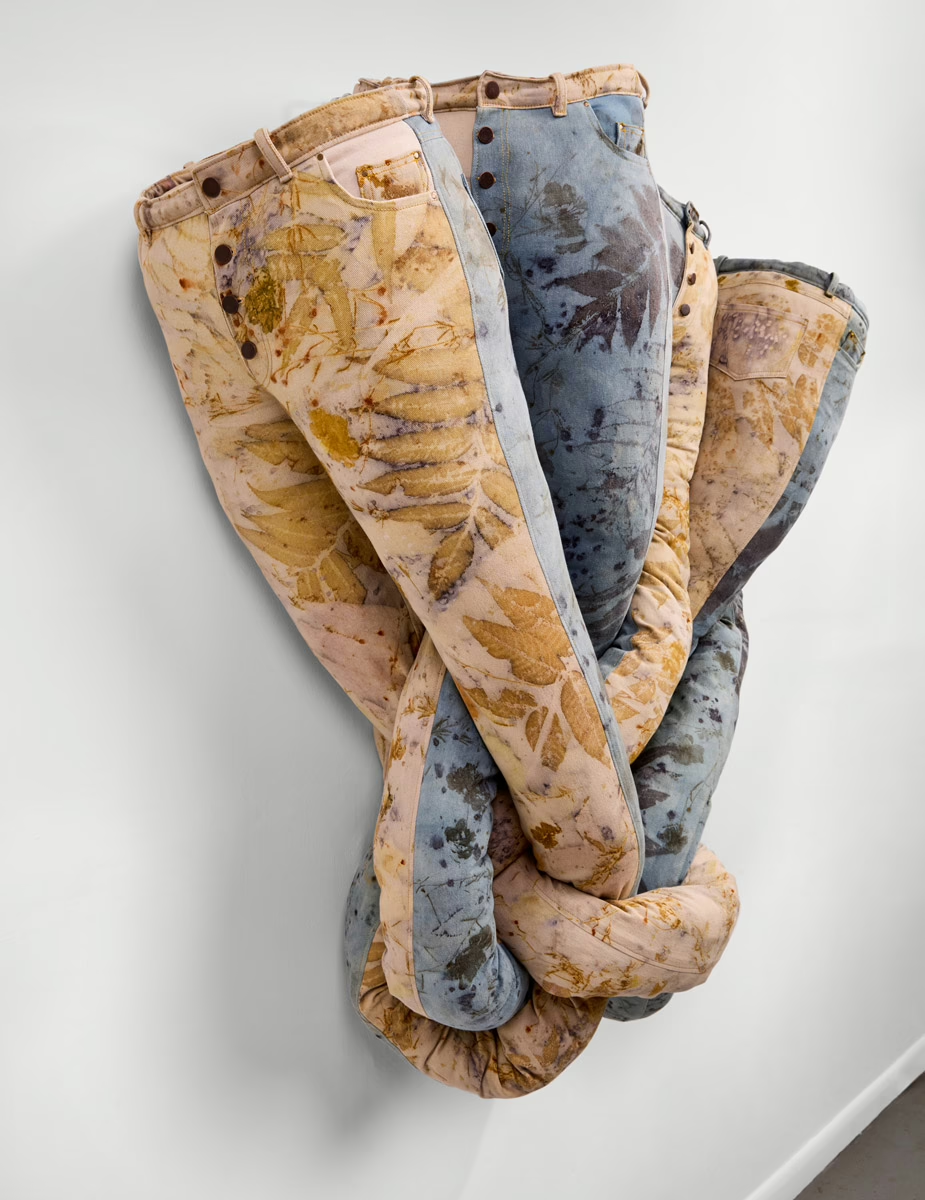
Christy Gast, Four Button Fly, 2024, Contact printed denim dyed with indigo, sumac and iron, copper, fiber fill, 54 x 48 x 9 in.
-
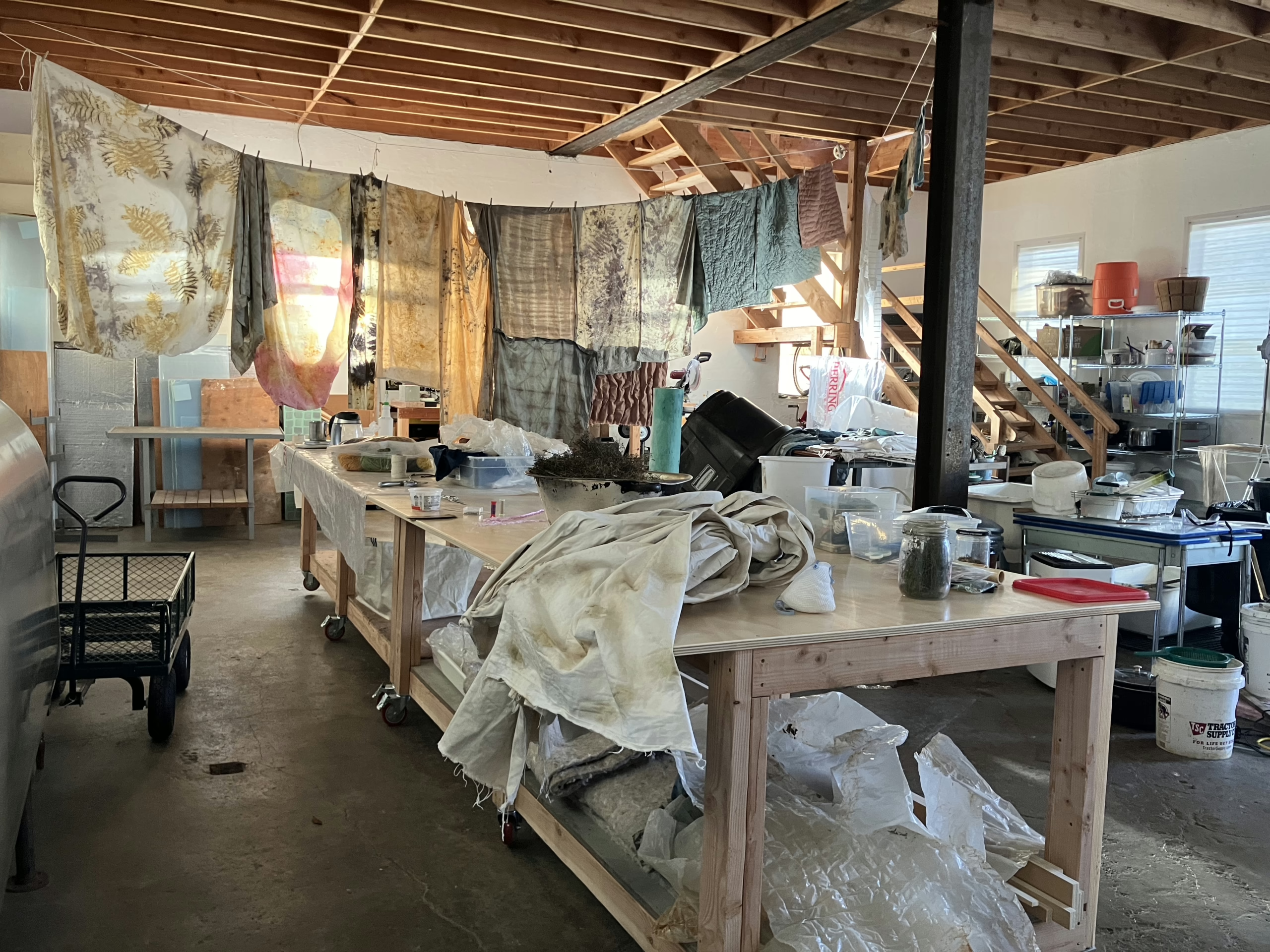
Christy's studio.
I was doing a lot of residencies at the time and realized that, apart from the larger trees, I saw the woods as an undifferntiated wall of green. I began to educate myself. I knew that dye processes could coax colors out of plants and so I set about developing a color palette in collaboration with the places where I was working. With a mobile “tinctorium” or dye studio in the back of my car, I began systematically studying identification, scientific nomenclature, chemistry, cultural uses and ecosystem relationships of plants I collected on foraging walks. This led to a series of wool sculptures named for the plants and techniques used in their production, as well as poetic, process-based workshops and installations.
In 2022 I moved into a new studio and was able to increase the scale of my dye experiments. I have a wet room where I work with 30 gallon vats instead of stovetop dye pots that can only hold a few gallons. This makes it possible for me to dye yards of fabric instead of smaller swatches of wool. I am printing directly from plants onto yardage using a process that feels alchemical. In a series of steps, I coax molecular-level bonds between the cellulose fibers (cotton, linen), metals, salts, proteins and finally plant chemistry. A part of this process has been used to make ink since at least the 5th century, and is likely what Sappho used to write poetry on parchment or papyrus.
-
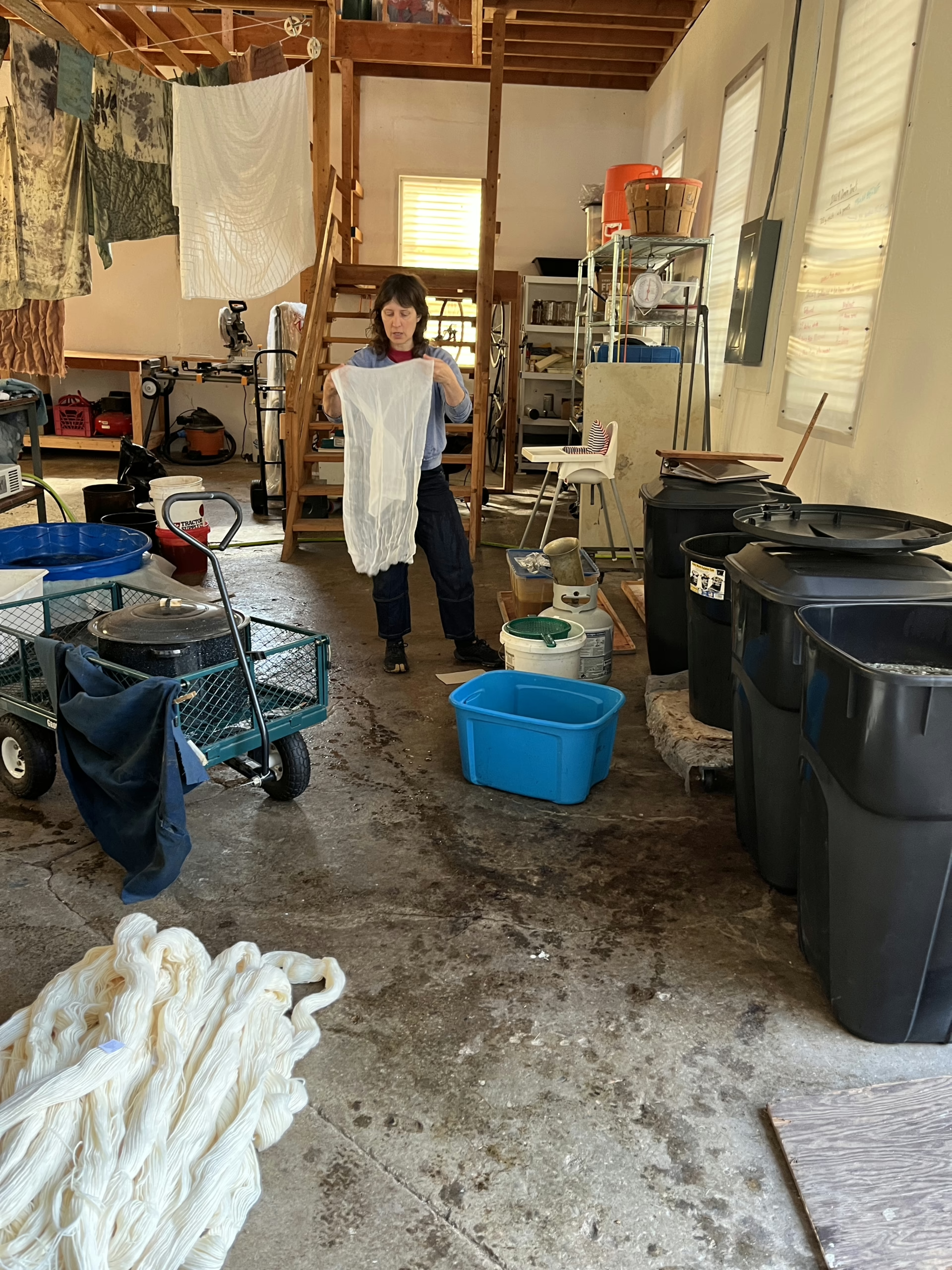
Christy Gast in her studio in New York. Photography by Janis Stemmermann.
The surface pattern on “Four Button Fly” was directly printed from plants and flowers growing just outside of my studio. I cut the pieces first, then prepped the denim with various mordants. Then I laid the wet pieces flat on the work table and arranged sumac, coreopsis and other flora on them before binding the pieces into a tightly wrapped bundle and steaming them for hours in a copper pot.
I have worked with readymade vintage blue jeans for years, and this is the first piece in which I’ve cut and assembled the jeans from raw denim. This is a technical process involving industrial sewing machines and specialized hardware. The piece is a continuous knotted loop where the leg of one pair of jeans connects directly to another like a mobius strip–eight legs and four asses with no beginning and no end. I created the floral camouflage and alternated between tannic brown and indigo blue overdye to introduce more visual confusion in the surface pattern.
-
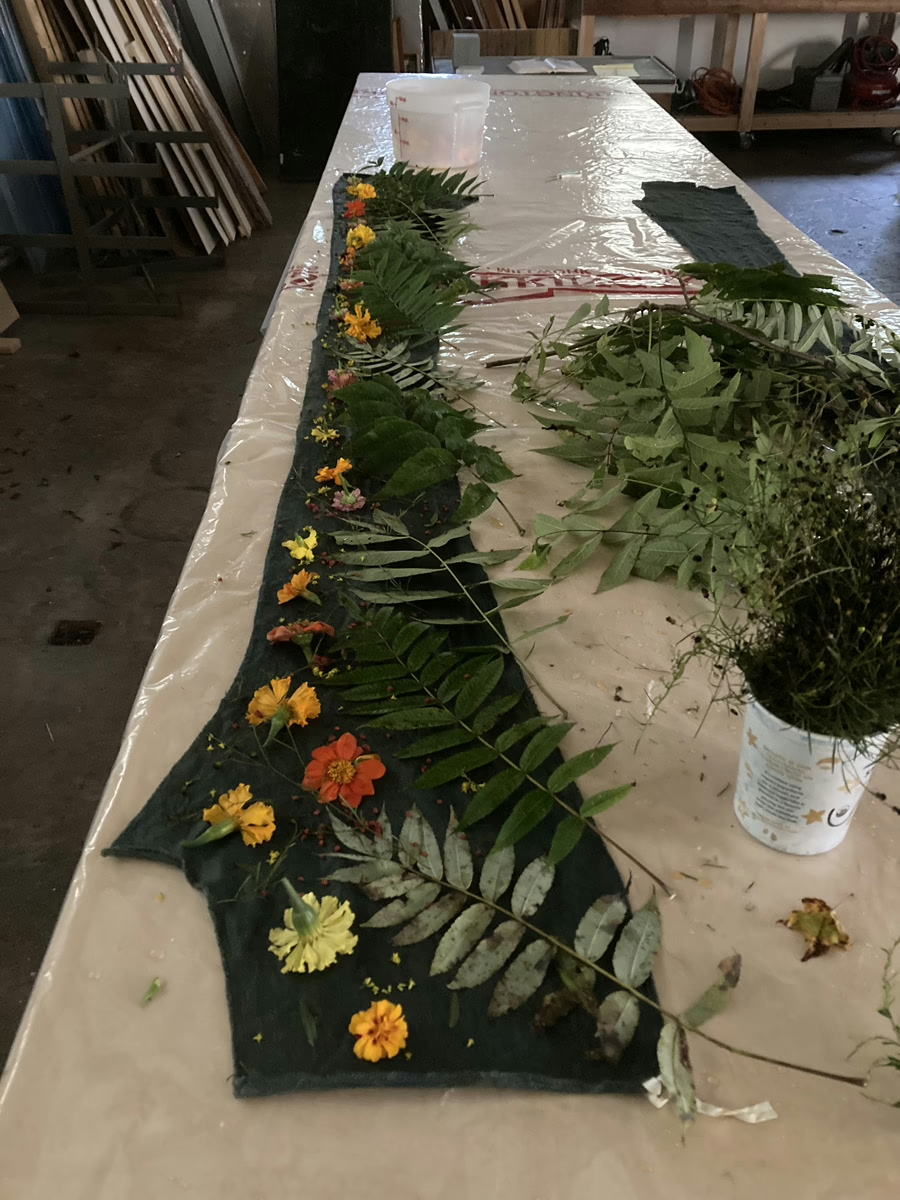
Christy's process in creating the surface pattern on denim.
-
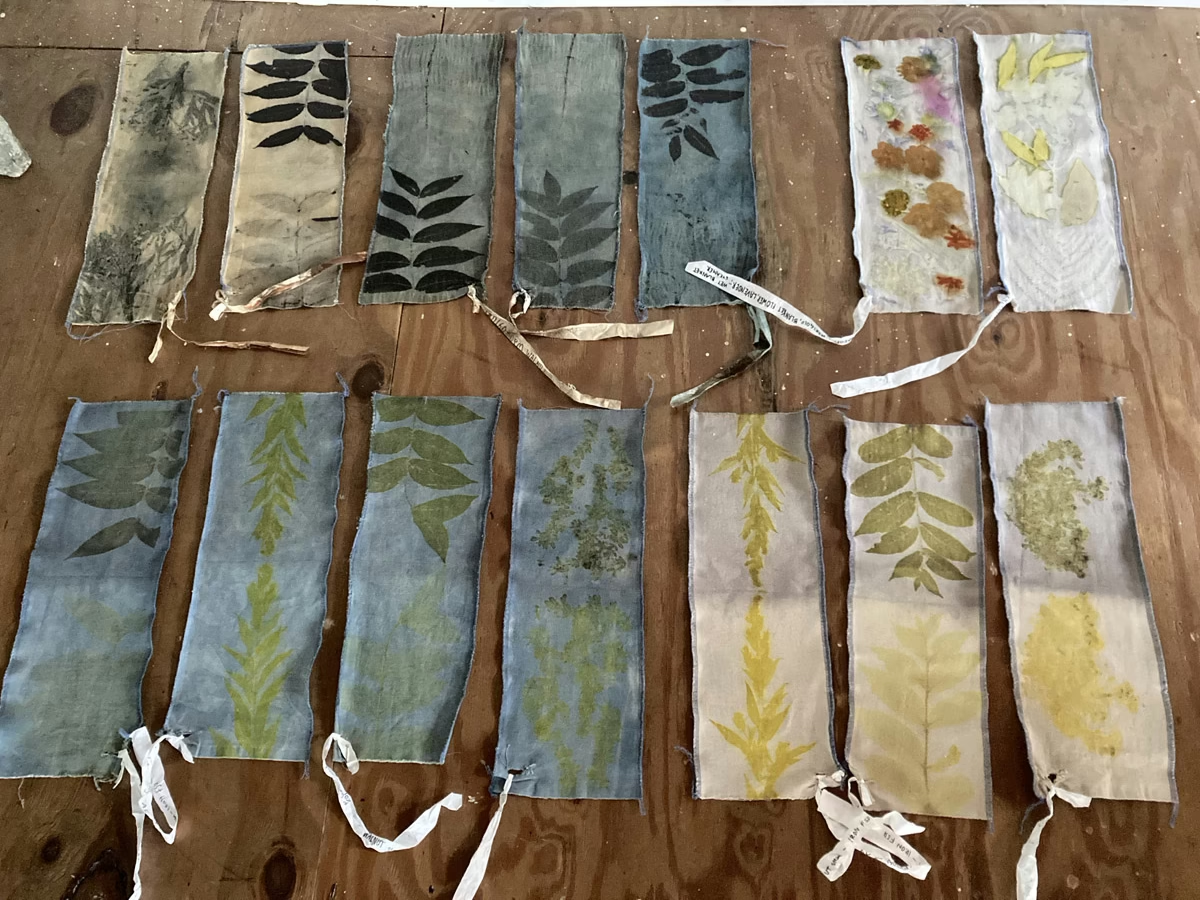
Test results of plant-dyed surface pattern on denim.
The other two pieces at Felix, “La noche está estrellada” and “Asses & Angels” are made from readymade vintage jeans. “Asses & Angels” clearly nods to the hanky code, a textile-based aesthetic signal by which the queer community historically communicated desires. This was done with colored bandanas stuffed into back pockets, and I admire the ingenuity of basing a secret code on this quotidian textile (my dad always had blue ones in his work uniform) that can be used to wipe sweat from the brow, protect your hair, blow your nose, get a date or tie your lover’s wrists together. I think a lot about the history of textiles. The bandana as we know it originated in India or the Middle East and got to the Americas through the colonial textile trade. The origin of the word means “to bind”, and the paisley pattern we associate with them originated as an ancient Babylonian fertility symbol.
I was working with yardage of a very lightweight bandana cotton for this piece and wanted to make it flow out of the pockets and wrap around the asses in a way that defies logic. I have spent days in the Uffizi Galleries studying the progression of textile depiction in Medieval through Renaissance painting. The recent Siena show at the Met had a great section on this. The Silk Road innovations that reached Europe in that era–fine silks with gold thread woven in–expressed wealth and extravagance. The way the light bounces off of them in paintings shows the painter’s skill and the opulent, gravity-defying draping communicates the patron’s unimaginable wealth. I love it when there is so much fabric so extravagantly draped that it defies logic. There is no way that it could ever be flattened back into a plane. That’s what I was going for.
-
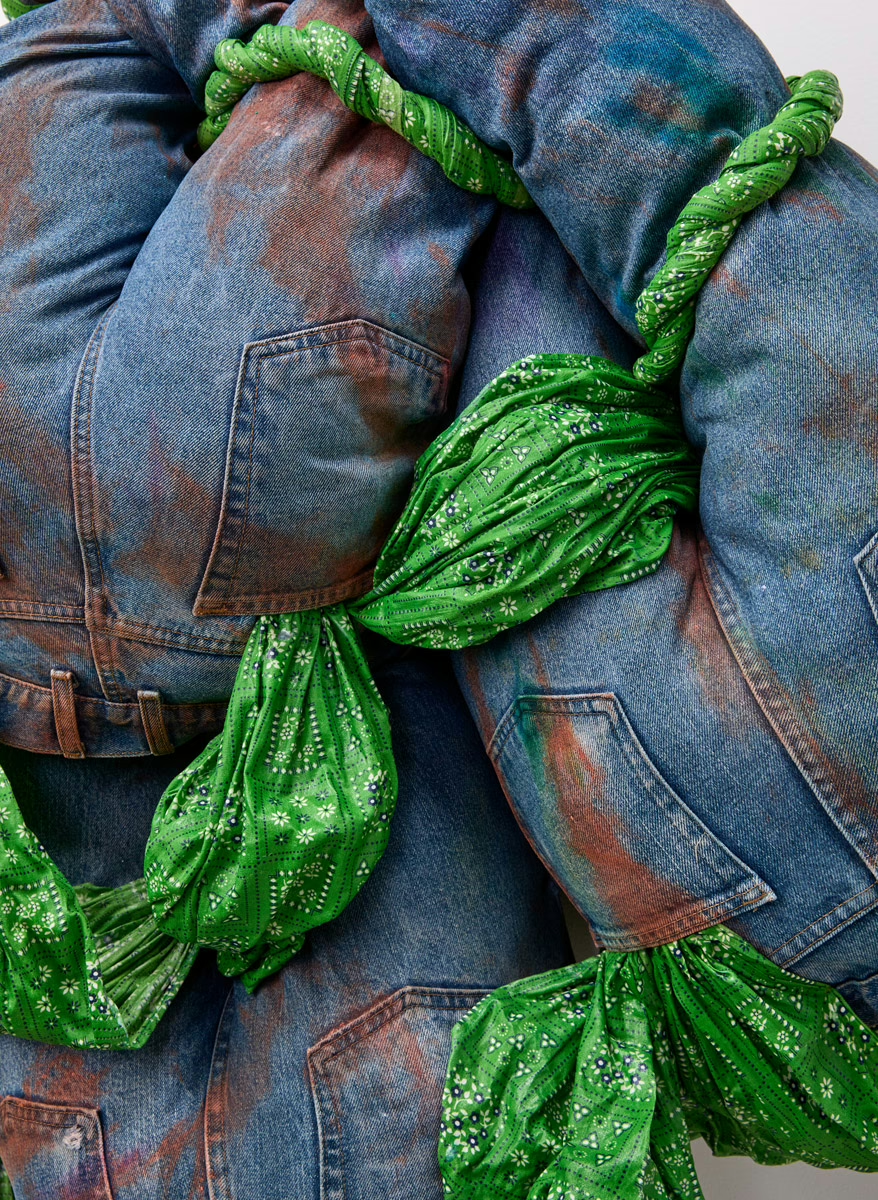
Christy Gast, Detail of Asses & Angels, 2023, Denim, cotton, gouache, poly-fil, 49 x 37 x 13 in.
“La noche está estrellada” began with a drawing as well, and it started as a much bigger piece, another impossible knot spilling out of a kneeling figure. I’ve been thinking a lot about mounting hardware with these pieces–climbing harnesses, strap-ons, O rings, carabiners–the contrast between hard and soft. I decided that this one needed a chain wallet, more quotidian queer coding. I attached a wallet that I inherited from my grandparents in Indiana, which I think was a gift from when my uncle was a priest in Chile. My grandfather was a union plumber and my grandmother was skilled at making garments, which she passed to my mom (one of 10 daughters) and to me. The wallet is stamped with a portrait and quote of a poem by Neruda about desire and loss. The piece already had the disco ball finish on the waist and I thought about Neruda’s line on the wallet poem. It’s about writing the saddest verse. The night is starry and the poet is alone. In the sculpture there’s a physical body and an implied body, that of the viewer, reflected in the mirrored fragments. Mute desire.
One of many things I love about vintage denim is that it’s not implicitly gendered. Or maybe it is–it makes everybody equally butch. I rolled up the ankles of the jeans so they’d fit me, so there’s that small aspect of self portraiture, but I think that’s there in all of the pieces. They relate to my body as the garment-maker. And denim is tough by design. The origin of the word is “de Nîmes” because it originated in the weaving mills of Nîmes in France. The 3×1 twill (indigo-dyed warp, white weft) made durable fabric that would shed water for use on sailing ships. Nîmes, in fact, is not far from where the other “Starry Night” was made, on the other side of the Rhône in Van Gough’s room at the Saint-Rémy-de-Provence asylum, where he felt profoundly alone.
-
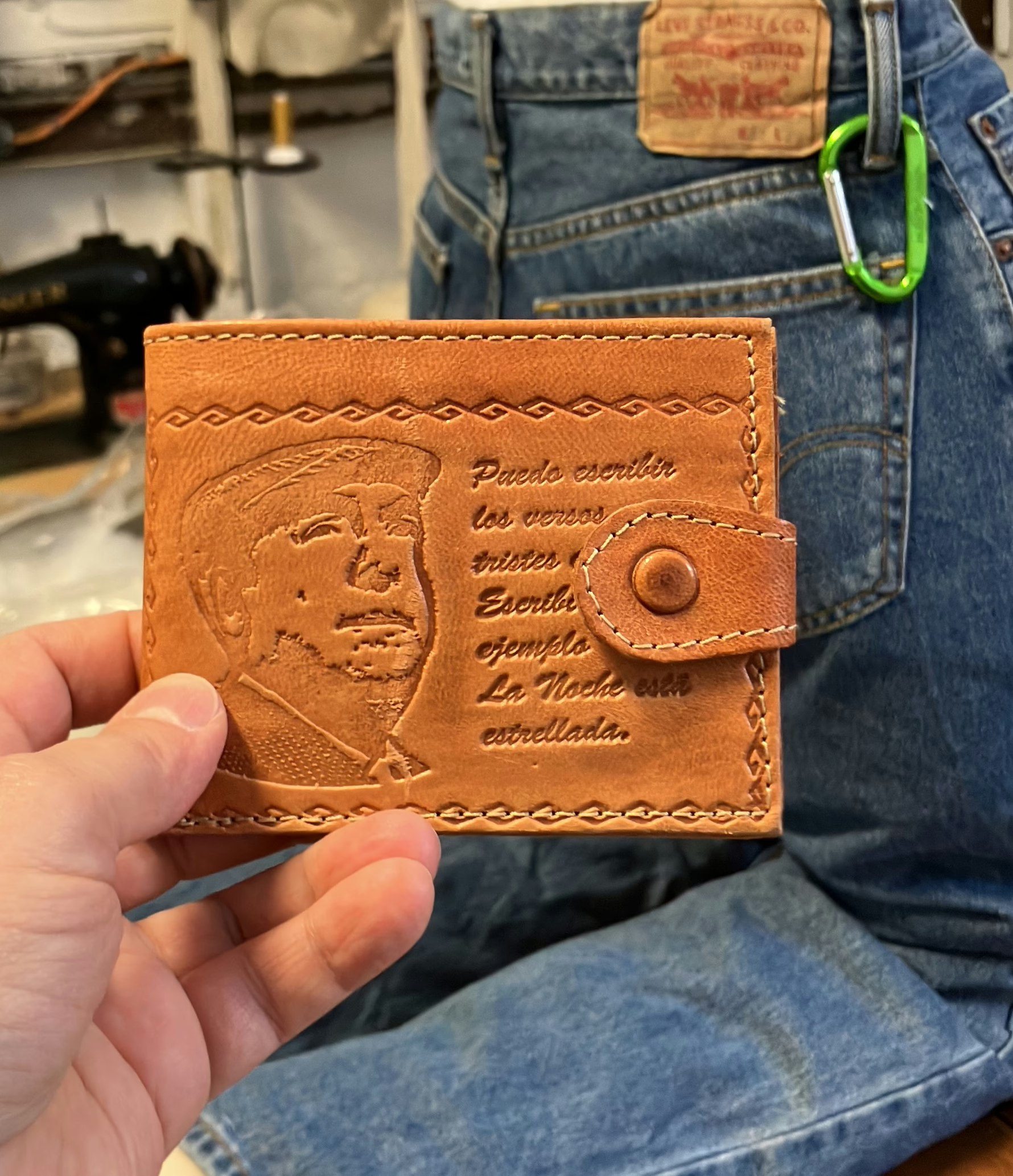
Wallet detail from "La noche está estrellada," (2025).
-
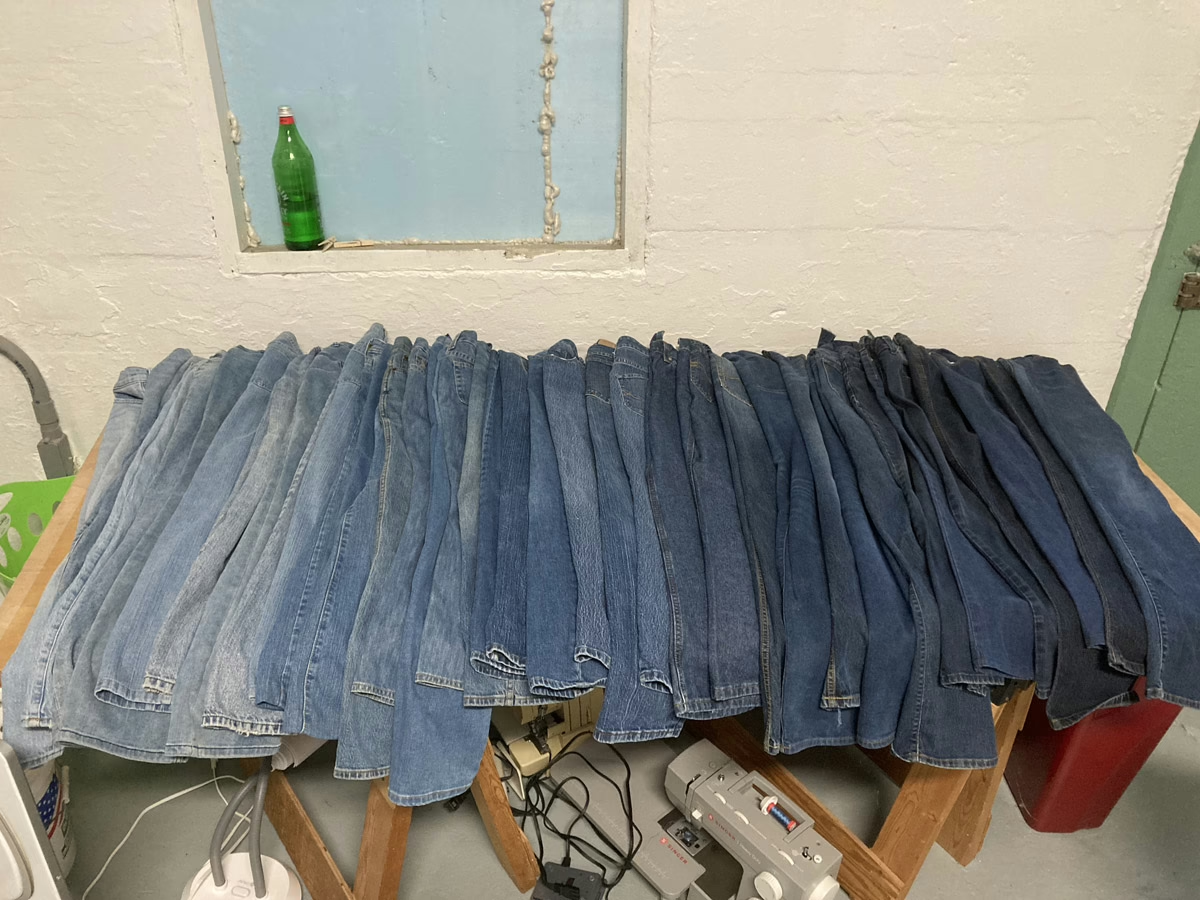
Sourced readymade vintage blue jeans.
The story with “Bog Skirt” is that I was looking for the oldest known depiction of a textile in another medium. I learned that very early “Venus” sculptures (30,000+ years old), those voluptuous stone carved female deities with huge tummies and breasts, are sometimes depicted with either a single twisted string around their waist or a string skirt. String skirts are fantastic early garments because they rely so heavily on the twist, which is the earliest structural innovation in textiles. To make a two-ply cord, the basis for all knitted and woven materials, first you twist the loose fibers in one direction to make a single fragile cord, then you hold two of those next to each other and twist them in the opposite direction, which greatly increases their tensile strength. Every additional doubling and twisting decreases the likelihood of the cord pulling apart.
Some of these string skirts, which were sometimes so short as to be belts (they didn’t cover below the tummy in the very early sculptural depictions) survived into the 19th and 20th century because they were preserved in bogs or other tannic environments. Tannic acid occurs naturally in plants and is used in many textile dye processes. It is also a natural preservative, it sort of pickles certain kinds of fibers. One example of an early textile preserved in this way is the skirt worn by the Egtved Girl, who was buried in an oak coffin in Denmark 3000 years ago. The tannic acid in the log preserved her and her garments. I wanted to recreate one of these string skirts and play with scale. I found an archeological drawing and increased my copy by a factor of two.
By increasing the scale, I was thinking about how each doubling of the ply increases the cord’s strength. I wanted to make the piece oversized and pendulous like the breasts on a Paleolithic Venus sculpture. I twisted my cordage using strips of old knitwear sourced from a local thrift store (they save bags of unsellable t-shirts for me). I pictured the vast mountains of discarded fast fashion textiles in the Atacama desert that will never decompose, our sad contemporary contribution to the archeological record. I soaked the cordage in a murky brown walnut bath, rich in tannins, before weaving the skirt. It’s finished with clay beads with a bronzed patina, after some Bronze Age pins and brooches in the Met’s collection. Finishing string skirts with bronze beads was fairly common and I can only imagine how the weight and jangle would have made them move and sound.
-
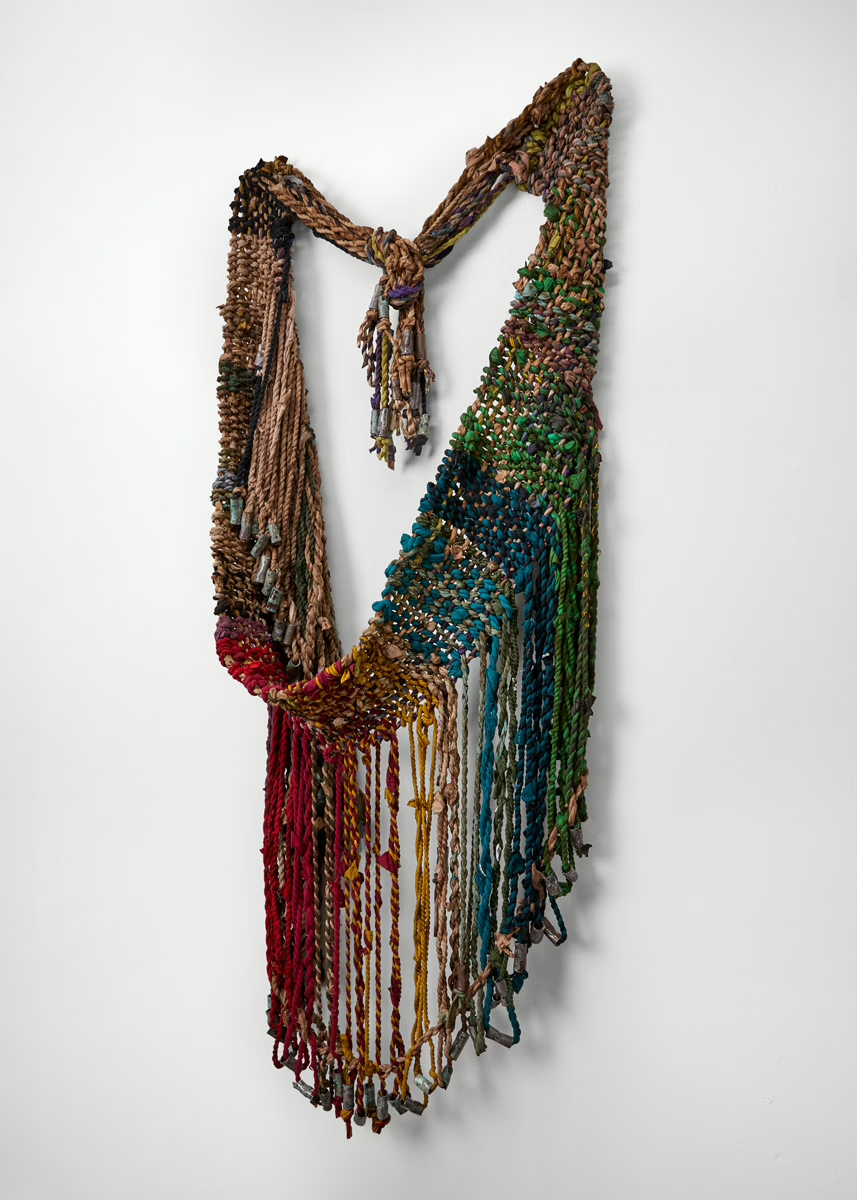
Christy Gast, Bog Skirt, 2024, Repurposed Textiles, ceramics, 76 x 36 x 8 in.
-
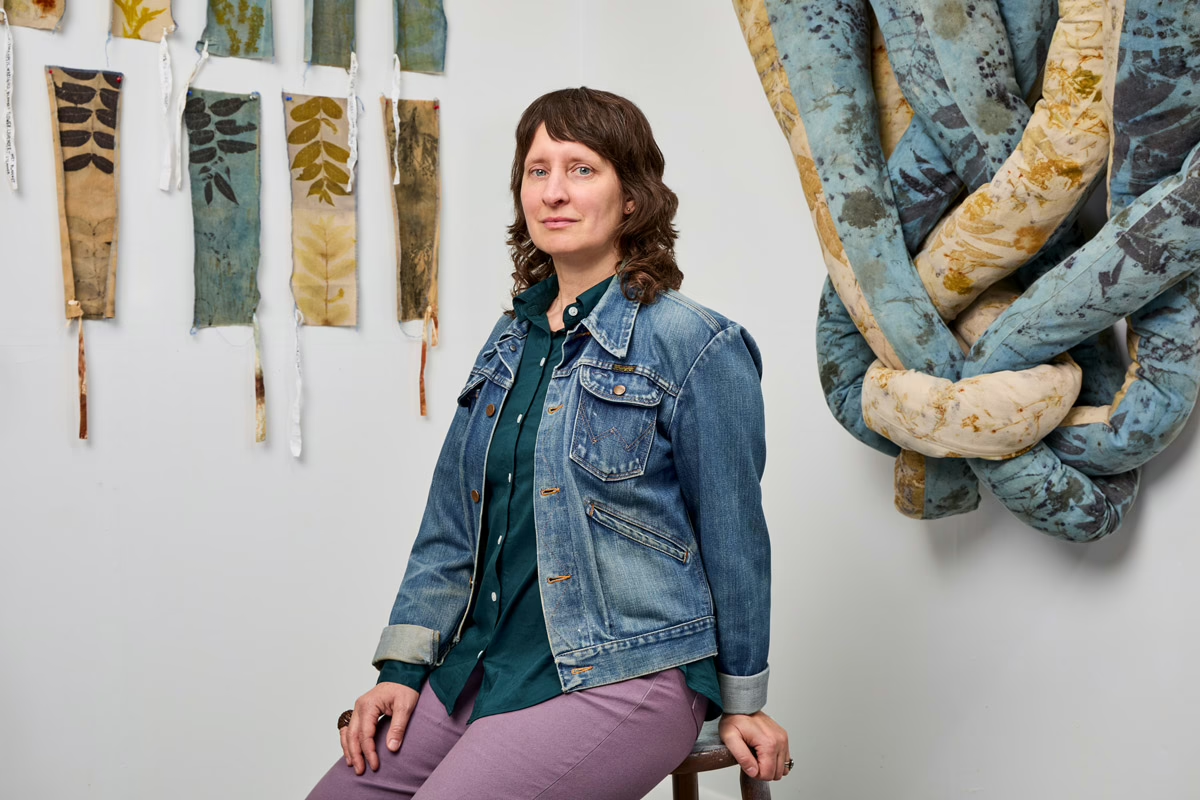
Portrait of Christy Gast in her studio. Photography by Joshua Simpson.
Christy Gast’s work has been exhibited at museums and galleries internationally, including the Kadist Foundation in Paris, MoMA/P.S.1 Contemporary Art Center, Artists Space and Regina Rex in New York; L.A.C.E. and High Desert Test Sites in California; Nina Johnson, Perez Art Museum Miami, the de la Cruz Collection, the Bass Museum of Art and Locust Projects in Miami; and Centro Cultural Matucana 100 in Santiago, Chile.